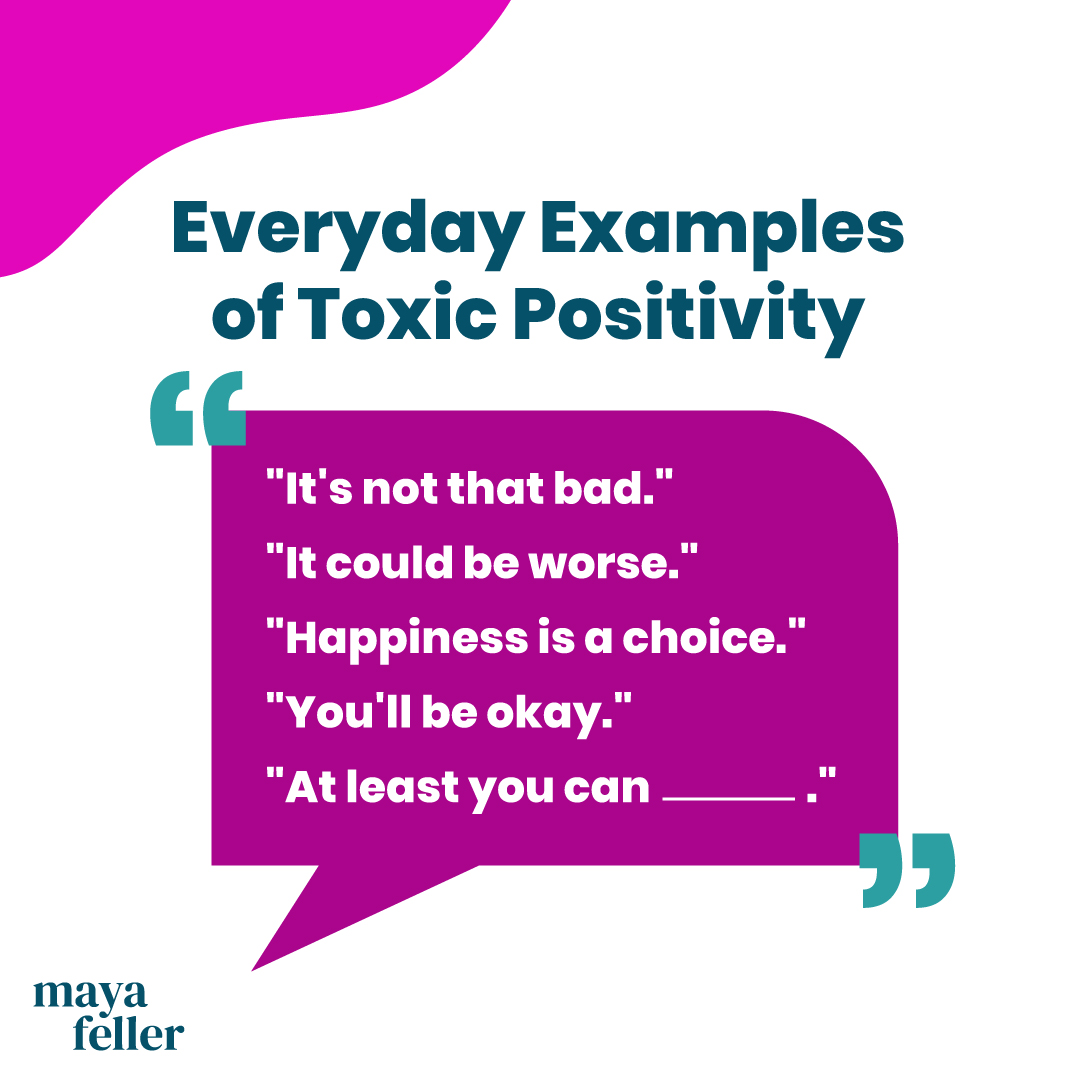Are You Practicing Toxic Positivity? Here’s Why to Stop
We live in a world where many people are constantly downplaying negative events in an effort to “stay positive.” While this may be more comfortable for many, this habit is actually known as toxic positivity, and research has shown that it can be incredibly detrimental to our mental health.
Let’s take a look at some of the common examples of toxic positivity so you can determine how often you encounter this in your everyday life—and if you’re even doing it yourself.
Then we’ll review how toxic positivity impacts your health and well-being along with tips on how you can minimize it and begin to reframe while acknowledging all of the facets of life.
Depending on your personal situation, you may also find that you may benefit from seeking the counsel of a trained mental health professional.
What is Toxic Positivity?
Trying to have a positive outlook is known to be a healthy practice, with numerous studies showing how beneficial it can be. In fact, I encourage it with my patients when warranted.
For example, a 2021 study on 550 cardiac patients revealed that simply maintaining a positive disposition not only helped them be more confident in their ability to regulation emotions but also aided their likelihood of following their doctor’s recommendations, which supported a higher quality of life. [1]
Likewise, a 2018 study on 240 children confirmed that positivity supports your brain’s ability to function properly by showing that children who maintained a positive attitude about math achieved greater academic success in the subject. [2]
So, as you can see, positivity certainly has its benefits—but it also has its place. And when the positivity culture limits your ability to effectively process negative events or emotions such as fear, disappointment, hardship, or anxiety, it can become toxic.
Toxic positivity is the belief that one should remain in a positive mindset regardless of their situation.
Examples of this include:
- Recently miscarried? At least you can have/already have children!
- Lost your job? It could be worse—your partner/spouse could be unemployed as well!
- Disappointed that you didn’t receive something you’ve been working for? You’ll be okay—just try again!
- Have limited access to the ingredients you need to make one of your favorite holiday meals from childhood? Hey, just be grateful you have food!
It goes on and on. And the problem has only become larger with the pandemic. These days, as we begin to believe that we should always remain positive, we’re seeing more and more feelings of guilt, despair, anxiety, and even depression.
The Dark Sides of Toxic Positivity
So, how does toxic positivity directly impact our day-to-day lives? Here are a few real-world examples.
Broken Relationships
Toxic positivity can cause broken relationships in a few ways. First, we need healthy relationships in our lives to help support our mental well-being.
When you’re surrounded by people who maintain a “positive vibes only” attitude, it can cause you to feel unvalidated and misunderstood, which can cause you to withdraw from the relationship. But there’s more ….
Constantly feeling unvalidated can leave you questioning your own judgement, which could put you in harm’s way.
According to a review of 29 studies, feeling pressure to remain positive irrespective of your circumstances can actually cause people in abusive relationships to underestimate the severity of the abuse, resulting in exacerbated mental and/or physical harm. [3]
Worsening Mental Health
Remaining in an “always positive” mindset limits your exposure to negative emotions, which can impact your ability to process and work through those emotions. At its root, toxic positivity is an attempt to avoid pain and uncomfortable emotions, which is a very unhealthy practice.
In fact, older studies have shown that simply recognizing, labeling, and acknowledging negative emotions can help to reduce their activity in your brain. [4]
Think about it this way: That’s the reason why we help younger children learn how to label their feelings. Once they know what they’re feeling, they can more accurately identify solutions or steps to take to feel better.
Without acknowledging negative emotions, it’s virtually impossible to move beyond them, and this leaves you more vulnerable to mental health issues.
According to a 2014 review article, dysfunctional emotional regulation strategies, such as toxic positivity, not only increases the likelihood of depression and anxiety but also leaves you more vulnerable to developing physiological disease. [5]
Worsening Physical Health
So, how does toxic positivity impact your physical health as well? Studies have shown that suppressing negative emotions can actually cause a rise in mortality rate.
According to a 2013 study, those who suppressed their emotions were 1.35 times more likely to die from all-cause mortality, while some cancer mortality rates increased by 1.7 times and heart disease mortality by 1.47 times. [6]
4 Steps to Avoiding Toxic Positivity
A strategy to modify toxic positivity is to reframe and replace it with healthy optimism. Here are four steps you can take to be mindful of toxic positivity and move toward supporting those you care about and yourself.
1. Practice mindfulness.
The first step in acknowledging toxic positivity is to slow down and be mindful of what someone is going through. Consider the emotional toll of the person in the situation. Allow for space and time for the process.
If you’re the person being affected by a negative situation, acknowledge to yourself that it’s okay and completely valid to feel the way you do. And if you feel you need additional support, reach out to a qualified mental health care provider.
Recognizing and allowing space to feel those emotions is a critical piece of the puzzle.
2. Communicate clearly.
Second, make sure you communicate clearly with the person you’re supporting or with others who are trying to support you during a difficult time.
This is done by intently listening to the person you’re supporting regarding how they’re feeling and what they need. Simple statements such as, “I’m listening,” and “I’m here for you” are enough.
If you’re the person hurting, try to clearly express your feelings with simple, direct statements, such as, “I feel disappointed right now, and I need time to sit in that feeling for a moment.”
3. Don’t ignore negative emotions.
As I mentioned above, the desire to suppress negative emotions is the very root of toxic positivity. But when we ignore them, they are unable to resolve and become even bigger problems.
Labeling your emotions is key if you’re the person who’s upset. And if you’re the support person, saying truly comforting phrases—not uplifting ones—is what’s needed.
4. Validate feelings.
That brings us to the last step: Validate your and others’ feelings. Instead of saying, “It’ll be okay,” or “You’ll get through this,” consider saying, “What you’re feeling is valid. I know that must be really hard to deal with.” This holds true even if you’re validating your own feelings.
Because our basic human nature is to help, it’s important to know that if you are the support person, you can ask if there’s a way you can help or make it easier for them. Likewise, if you’re the person hurting, ask yourself what would make the situation easier for you.
Remember, it’s okay to not always be “okay”—and that by learning to acknowledge and process negative emotions and being aware of toxic positivity, you’ll begin to reframe your relationship with both negative and positive emotions.



Leave a Reply